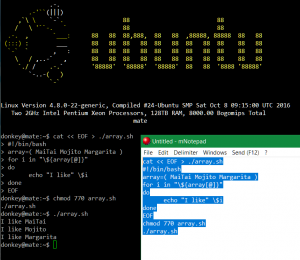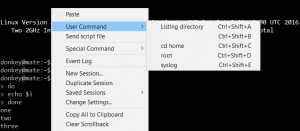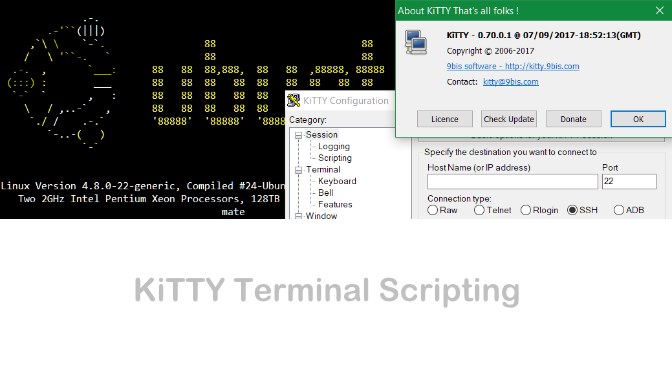PuTTY oder doch KiTTY
KiTTY ist ein Telnet- und SSH-Terminal Emulator für Windows. Die Software ist eine Alternative zu PuTTY und wurde als PuTTY-Clone/Fork entwickelt und ist auch als portable Version erhältlich. Des weiteren werden Raw, Rlogin, ADB, Cygterm und Serial Terminal ermöglicht. KiTTY ist im selben unauffälligen lock and feel gehalten wie PuTTY, bietet jedoch einige nützliche Erweiterungen.

Ein Feature von KiTTY ist der integrierte Editor, mit diesem beim entwickeln und Testen von Scripts die Arbeit im Terminal erleichtert wird, mit <Shift+F2> ruft man den Editor auf.

Die Code Zeilen aus dem mNotepad können zeilenweise oder als markierten Bereich mit der Option Send (F12) zum Terminal gesendet werden. Das Testen von Code Snippets in der Linux Shell kann so schnell und einfach ausgeführt werden.
Mit <Ctrl+Rechte Maustaste> erscheint das Kontext Menu mit den Optionen, so können Scripte über Send script file übertragen werden die im Terminal Shell ausgeführt werden. Die Option User Command bietet die Möglichkeit häufig verwendete Befehle auszuführen, die in der Registry gespeichert werden.


Falls vorhanden kann WinSCP aufgerufen werden, es wird direkt eine Verbindung zum Host aufgebaut, oder man wählt die Dateiübertragung über Send with pscp.
Wer die Sessions und Hosts Parameter nicht in der Registry verwalten möchte, dem bietet sich die Möglichkeit die Einstellungen in der INI Datei zu speichern. Dabei muss folgender Eintrag in kitty.ini eingefügt werden.
[KiTTY]
savemode=dirMit folgender Eingabe in der Eingabeaufforderung für die Verwaltung ohne Registry:
kitty.exe -convert-dirHierdurch werden unter dem Programm Ordner 6 Unterordner angelegt, die Einstellungen werden in den Ordnern Commands, Folders, Launcher, Sessions, Sessions_Commands und SSHHostKeys abgelegt.


